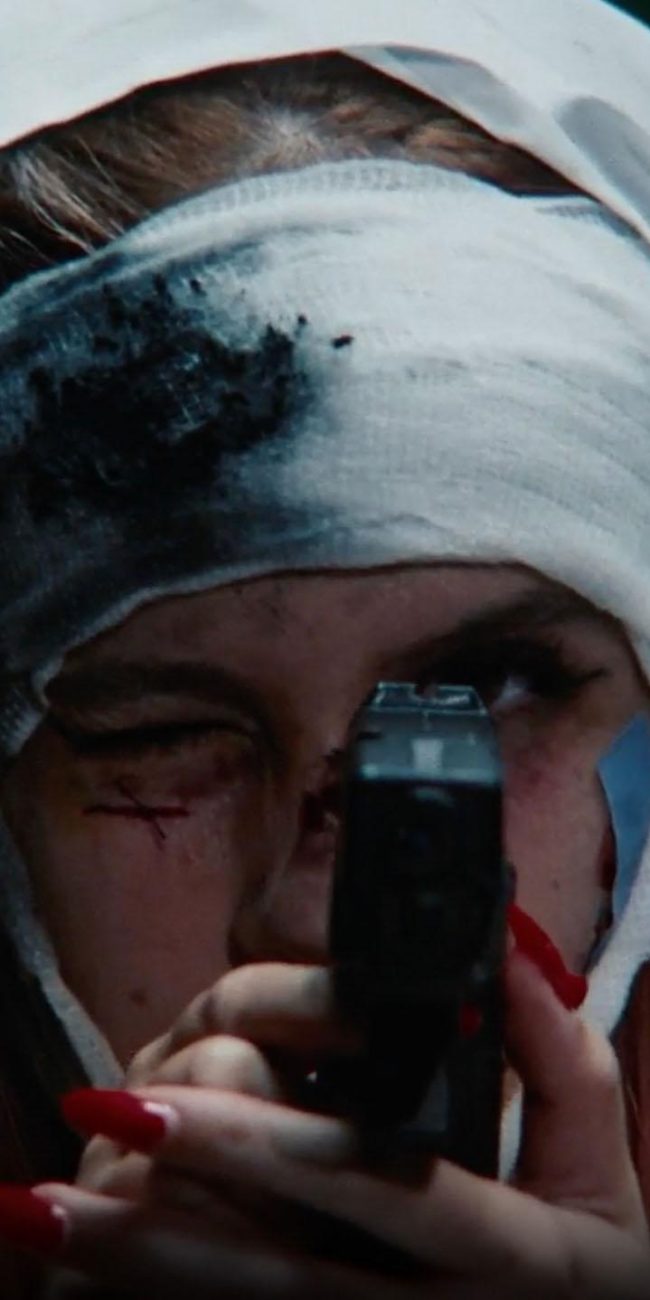Nick Toti’s “Digital Gods”- Season Two, Transmission Five (Part 2)
In the last Digital Gods installment, we examined the cultural context surrounding MDMAfilms, the production company created by authors Megan Boyle and Tao Lin. This article will now look at the actual movies that MDMAfilms produced. Particularly, this piece will analyze their three feature-length documentaries, MDMA, Bebe Zeva, and Mumblecore.
MDMA

I keep returning to the word “gimmick” in describing the methodology of MDMAfilms. I think it’s the correct word, but it requires some qualifying statements since calling something a gimmick has negative connotations. I’d like to break from those connotations. Ladies and gentlemen, let me state without reservation: I love gimmicks. Once upon a time, the “moving picture” was nothing more than a gimmick and many of the medium’s significant developments have entailed a degree of gimmickry. Let us pause now to celebrate whatever it takes to gets the rubes in the tent!
With that little PSA out of the way, I can now state, without reservation, that MDMA is the most gimmicky movie that MDMAfilms produced. A short synopsis would read: “Tao Lin and Megan Boyle use a MacBook to record themselves ingesting MDMA and exploring New York City. The entire movie plays out in one long, shaky, low-resolution, uninterrupted take.”
MDMA is the type of movie that may be more fun to read about than to actually watch, but, for those willing to make the two-hour investment, it does offer many pleasures. For one, there’s the absolutely brazen simplicity of it all. To plagiarize Lester Bangs on Metal Machine Music: any idiot with a laptop could have made this movie. That’s what makes it so good. With the right drug connections, we could all go out and make it. Every truly “independent” filmmaker (i.e. those with no funding who are beholden only to their own obsessive whims) is making glorified home movies. Boyle and Lin are just shameless enough to own up to it.
The thing that surprised me most about watching MDMA was how much it reminded me of numerous other, more “normal,” movies. For instance, The movie opens on our protagonists sitting in a vehicle. Off the top of my head, I can rattle off a bunch of movies that start in this way: Slacker, Waking Life, Before Sunrise (Linklater loves these openings), Some Came Running (Linklater’s favorite movie, for what it’s worth), Carnival of Souls, The Texas Chain Saw Massacre, Night of the Living Dead (and probably dozens of other horror movies), etc. It’s not a profound observation, but there is something telling in the detail. For a movie that includes only two edits (the entry point and the ending point), these choices can’t be treated as arbitrary. It may not have been a hyper-conscious choice, but there’s something about it that prepares the viewer for a journey. In this case, the journey is simultaneously geographical, emotional, and chemical.
The car is the setting for the main underlying action of the movie: the ingestion of MDMA. We see Megan and Tao take the drug and then spend the rest of the movie watching them interact as it takes effect. Since we see this play out in real time, the result is a bit mixed. Some of it is exciting and energetic, but some is dreadfully dull. Long portions play out with the camera almost completely obstructed or pointing at nothing in particular. Very little about MDMA suggests that it was in any way designed for the viewer’s enjoyment, so it begs the question: why watch it?
I mentioned Linklater earlier for a reason, which is that MDMA really reminds me of his movie Before Sunrise. The pleasure of watching MDMA is the pleasure of watching two smart, funny young adults enjoy each other’s company while possibly also falling in love. MDMA is a romantic movie and, as we’ll see in more detail in their later movie Mumblecore, Boyle and Lin are in a complicatedly romantic relationship. It’s hard to parse out which parts of their interactions are natural emotional exchanges and which are induced by the drug that they’ve taken, but that’s also part of the enjoyment. People take drugs as a way to get to know each other differently, so why should one experience be favored as more legitimate than another? Chemicals aside, Boyle and Lin are fun to look at and listen to and their enthusiasm during this experience is infectious.
MDMA ends with Boyle and Lin riding an indoor ferris wheel at the Toys-R-Us in Times Square. Like the opening, this is significant because it was one of the two clearest creative decisions made in the movie. Apparently, they recorded for around four hours, so ending here was clearly a choice. Why end in a ferris wheel? Like opening in a car, I’d suggest that ending a movie in a ferris wheel has a distinctly cinematic vibe. There have been a number of movies that end or contain climactic scenes taking place at carnivals. The lights, noises, and general kineticism makes this type of setting feel emotionally appropriate to conclude even the loosest of narratives. Boyle and Lin, like most Americans, have presumably digested enough pop culture to internalize this and it makes a perfectly fitting end to their adventure. Sitting still, they paradoxically continue moving with the knowledge that this wheel will return them safely back to the place where they started. Like the drug they’ve taken and the movie they’re making, the ferris wheel itself is about their time spent together more than where it will take them.
Bebe Zeva

As of this writing, Bebe Zeva is my favorite MDMAfilms production. The things I like about it range from incredibly simple to somewhat complicated. That seems like as good of an organizing principle as any, so that’s how I’ll break down this analysis.
The Incredibly Simple Pleasures of Bebe Zeva:
The Premise: Bebe Zeva is very straightforward, which is nice following the more conceptual MDMA. Boyle and Lin travel to Las Vegas to document meeting Bebe Zeva, a seventeen-year-old fashion blogger. This is a fairly normal setup for a documentary. Bebe is an interesting figure with a naturally comfortable onscreen presence, so why not make a documentary about her?
The People: Whereas MDMA and Mumblecore show Boyle and Lin in a sometimes unflattering light (which, now that I’ve written it, I realize is true both literally and metaphorically), Bebe Zeva shows all three of its stars at their most charming, energetic, endearing, and charismatic. Given the nature of MDMAfilms, some of this may be the result of drug use, but that’s neither here nor there. These folks are simply a blast to watch.
The Lack of Etiquette: There’s a documentary I really like called The Emperor’s Naked Army Marches On about a Japanese political dissident attempting to bully the truth about Japanese war crimes out of high ranking military officials. At one point, he threatens someone he’s interviewing with physical violence if he doesn’t tell the truth. When the man doesn’t comply, the dissident comes out from behind the camera and starts beating the hell out of the interviewee. I absolutely loved this because it challenges so many assumptions we make about how documentaries are supposed to function. Bebe Zeva, in its own innocent way, does the same thing. Rather than beating Bebe up, though, Tao Lin is fond of coming out from behind the camera and feeding her absurd amounts of aerosol whipped cream or spraying it onto her face and hair. Over the course of the night, Boyle and Lin also encourage Bebe to eat what appears to be all the junk food in Las Vegas. Call me simple, but I find this extremely entertaining.

The Somewhat Complicated Pleasures of Bebe Zeva:
The Argot: I remember reading in college about the distinct challenges that the author Louis-Ferdinand Céline presents to translators. Rather than writing in the bourgeois literary French that was standard at the time, Céline wrote in the language of the lower classes while also mixing in specific jargons from the medical profession, military life, etc. Much of this language went otherwise unrecorded and has been lost to the history of ever-evolving dialects. Bebe Zeva reminds me of this because it is deeply rooted in the argot of media-saturated millennials who mediate significant portions of their lives through technology. If you ever typed the acronym “AFK” when chatting with friends on AIM, then you will have an advantage over other viewers who are either too old or too young to understand this terminology. As a snapshot of one specific moment in cultural history (November 27, 2010, to be precise), Bebe Zeva acts as a sort of time capsule. It will look and sound increasingly foreign to viewers the older it gets. This, for me, is one of its greatest strengths. The three protagonists are hyper-literate and incredibly self-aware. Their dialogue has a poetic quality that merits this documentation.
The Intertextuality: Every MDMAfilms production contains references to Boyle’s and/or Lin’s writing, but Bebe Zeva has one particular instance of this that takes on an unexpectedly surreal quality. For context: in 2009, Tao Lin published a novel (or “novella”–honestly, I’m unsure of the difference) titled Shoplifting from American Apparel. It tells a largely autobiographical story about Sam (based on Tao) being caught shoplifting from American Apparel and subsequently being banned from all American Apparel stores. In Bebe Zeva, there is a moment where our subjects are wandering through a busy mall-like place looking for a bathroom. They are directed toward an American Apparel store. When Tao says that he isn’t allowed to go in, Bebe goads him into doing it anyway, stating “What’s the worst that can happen?” It turns out that nothing happens. They ask an employee if they even have a “banned customers” list and she says that they don’t. What makes this moment so memorable is the sense of genuine apprehensiveness that Tao expresses. It’s a nice moment of real bad decision making and the viewer (like the characters) has no idea where it will lead. The fact that it leads nowhere is irrelevant to the enjoyment of the recorded moment.
The Formal Playfulness: Everything about MDMAfilms seems sort of half-aware of itself as a work of art. When Alexander Sokurov did Russian Ark in one long take, it was obviously meant as part of a grand artistic statement; when Boyle and Lin do it in MDMA, it feels completely impulsive and borderline pointless. One of the things I love about Bebe Zeva is that it has these scattered moments that feel more intentionally “artful.” Sometimes these moments are as simple as adding a title to comment on or highlight something about the action on screen. Others, such as the moody, poetic ending with everyone hanging out in, and eventually leaving, a beautifully bottom-lit swimming pool, accomplish something emotionally complex that’s difficult to pin down. Some viewers might find this sort of artsy-fartsy flourish unnecessary, but I find it a welcome reminder that all creative expression is a matter of perspective. There was something about these moments that made Boyle and Lin choose to emphasize them. The opportunity to hop inside someone else’s unique perspective, with all of its inherently unknowable mysteries, gives me pleasure.
Mumblecore

Mumblecore is the MDMAfilms production that I have the least to say about. It’s a particular kind of movie that could even be said to fall within a specific documentary subgenre. I don’t think that subgenre has a name, so I’ll just call it the “autobiographical lyric documentary.” Other examples include Chris Marker’s Sans Soleil, Jonathan Caouette’s Tarnation, Zack Oberzan’s Your Brother. Remember?, and Betsey Brown’s Shegetsey Betsey. These movies take scattered, often only loosely connected home videos that may or may not have been shot with the intention of showing publicly, and then organize them around a structural edifice that transforms the raw material into something approachable/consumable for audiences. When done well, these movies are really, really terrific.
Boyle and Lin began recording large portions of their time together shortly after they started hanging out. Mumblecore is a documentary about their relationship created entirely from this cache of hours and hours of recorded material. Since everything included was a moment captured as it was unfolding (as opposed to being broken up with talking heads commenting from the vantage point of the future or some other device typical to documentaries), the whole thing feels very immediate and intimate. We see Boyle and Lin fumble through their relationship with something that feels simultaneously self-consciously performed and totally vulnerable. We see them engaging in elaborate inside jokes, fucking (kind of; it happens in a quick jump cut in a hotel room), cuddling, discussing their past and present relationships, and other activities you might expect from two romantically involved twentysomethings. However, Boyle and Lin seem unusually inclined to do these things in places with interesting lighting that causes a distinctly cinematic effect. This tension between the private and the performative reaches its climax with Boyle and Lin eloping in Las Vegas– a traditionally happy ending that here feels utterly ambiguous.
Like the DIY, no-budget genre that inspired its title, Mumblecore is going to elicit mixed responses from viewers. Joe Swanberg’s early movies meant a lot to me when I was first exposed to them. Now that I’m nearly a decade older, my relationship with those movies has changed considerably. I imagine Mumblecore would function in a very similar way. For someone in their twenties or younger, it presents a glimpse into two people’s lives and might help the right viewer feel less alone. For an older viewer, it might feel overly indulgent and/or tedious, or it might create feelings of nostalgia or half-embarrassed self-identification. Honestly, a lot of viewers would probably watch this movie without the vaguest sense of how to process what they’re seeing. That’s fine too because Mumblecore, like all of MDMAfilms’s productions, doesn’t pander to any audience other than Megan Boyle and Tao Lin. They’re the heroes of this shit.
– Nick Toti (@NickTotiis)











